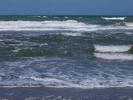Sensitive to Sea-level Rise? Climate Changes is to SpeedUp the Sea-Level

The U.S. Environmental Protection Agency, in association with NOAA and U.S. Geological Survey, recently released a report that argued the impacts of sea-level rise on the coast, coastal communities, and the habitats and species that depend on coastal areas, with a focus on the eight coastal states from New York to North Carolina. Sea level is rising, and there is indication that the rate of rise is accelerating. Climate varies is likely to speed up the rate of sea-level rise during the next century. From improved flooding of low-lying areas, to greater impacts from coastal storms, grind down shorelines, and the translation of wetlands to open water, growing seas can have severe impacts on coastal communities and habitats.
The report, Coastal Sensitivity to Sea-level Rise: A Focus on the Mid-Atlantic Region, uses controlled writing and policy documents to illustrate potential changes to barrier islands, wetlands, other coastal habitat, and vulnerable species; societal impacts and implications of sea-level rise; decisions that may be sensitive to sea-level rise; opportunities for adaptation; and institutional barriers to adaptation. It also outlines current coastal policy in the mid-Atlantic region and describes the implications for the other regions of the United States. The report also discusses opportunities for natural and social science research to enhance understanding of potential impacts of sea-level rise and society's ability to respond.
Key findings from Coastal Sensitivity to Sea-level Rise include the fact that rising water levels are already negatively impacting coastal areas and the effects of sea-level rise will be increased if the rate of rise accelerates in the future, as it is likely to do. The authors also report that most coastal wetlands in the mid-Atlantic would be lost if sea level rises one meter in the next century. Even a 50-centimeter rise would threaten most wetlands along the Eastern Shore of Chesapeake Bay.
Not all of the news, however, is dim. The report indicates that some governmental and nongovernmental organizations are already starting to prepare for sea-level rise and that preparing now can reduce the eventual environmental and economic impacts of sea-level rise. Possible responses to sea-level rise cited in the report include seawalls, bulkheads, and other shoreline armoring; elevating buildings and land surfaces (including beaches and wetlands); and allowing shorelines to change and moving structures out of harm's way.

Stephen Gill, Senior Scientist with the NOS Center for Operational Oceanographic Products and Services and the NOAA lead author for the report notes that "some of the most important findings are the assessment of gaps, or deficiencies in information, data, and tools needed to inform decision making at all scales of interest to all stakeholders. For instance, in many areas the fundamental elevation data are not at the resolution and accuracy required for detailed assessments of impacts of sea-level rise. The range of physical and biological processes associated with coastal change is poorly understood at the time and space scales required for decision making. However, the information in this report gives us a better understanding of where we are and where we need to be and that information in itself acts as a major stepping stone for making improvements to future reports during the new administration."
Coastal Sensitivity to Sea-level Rise is one of 21 climate change synthesis and assessment products being developed by the U.S. Climate Change Science Program, of which NOAA is a partner. The Climate Change Science Program was established in 2002 to provide the United States with science-based knowledge to manage the risks and opportunities of change in the climate and related environmental systems. The program is responsible for coordinating and integrating the research of 13 federal agencies on climate and global change.
 Deep Sea Crabs
Deep Sea Crabs